Jiecao Chen
Virtual Width Networks
Nov 17, 2025



Abstract:We introduce Virtual Width Networks (VWN), a framework that delivers the benefits of wider representations without incurring the quadratic cost of increasing the hidden size. VWN decouples representational width from backbone width, expanding the embedding space while keeping backbone compute nearly constant. In our large-scale experiment, an 8-times expansion accelerates optimization by over 2 times for next-token and 3 times for next-2-token prediction. The advantage amplifies over training as both the loss gap grows and the convergence-speedup ratio increases, showing that VWN is not only token-efficient but also increasingly effective with scale. Moreover, we identify an approximately log-linear scaling relation between virtual width and loss reduction, offering an initial empirical basis and motivation for exploring virtual-width scaling as a new dimension of large-model efficiency.
AgentGym-RL: Training LLM Agents for Long-Horizon Decision Making through Multi-Turn Reinforcement Learning
Sep 10, 2025Abstract:Developing autonomous LLM agents capable of making a series of intelligent decisions to solve complex, real-world tasks is a fast-evolving frontier. Like human cognitive development, agents are expected to acquire knowledge and skills through exploration and interaction with the environment. Despite advances, the community still lacks a unified, interactive reinforcement learning (RL) framework that can effectively train such agents from scratch -- without relying on supervised fine-tuning (SFT) -- across diverse and realistic environments. To bridge this gap, we introduce AgentGym-RL, a new framework to train LLM agents for multi-turn interactive decision-making through RL. The framework features a modular and decoupled architecture, ensuring high flexibility and extensibility. It encompasses a wide variety of real-world scenarios, and supports mainstream RL algorithms. Furthermore, we propose ScalingInter-RL, a training approach designed for exploration-exploitation balance and stable RL optimization. In early stages, it emphasizes exploitation by restricting the number of interactions, and gradually shifts towards exploration with larger horizons to encourage diverse problem-solving strategies. In this way, the agent develops more diverse behaviors and is less prone to collapse under long horizons. We perform extensive experiments to validate the stability and effectiveness of both the AgentGym-RL framework and the ScalingInter-RL approach. Our agents match or surpass commercial models on 27 tasks across diverse environments. We offer key insights and will open-source the complete AgentGym-RL framework -- including code and datasets -- to empower the research community in developing the next generation of intelligent agents.
Feedback-Driven Tool-Use Improvements in Large Language Models via Automated Build Environments
Aug 12, 2025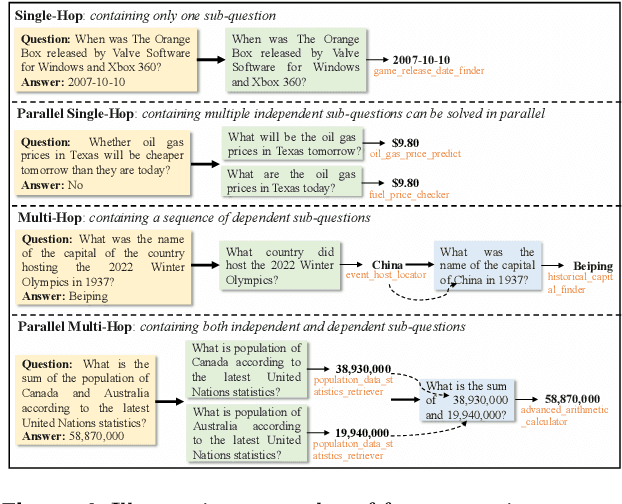

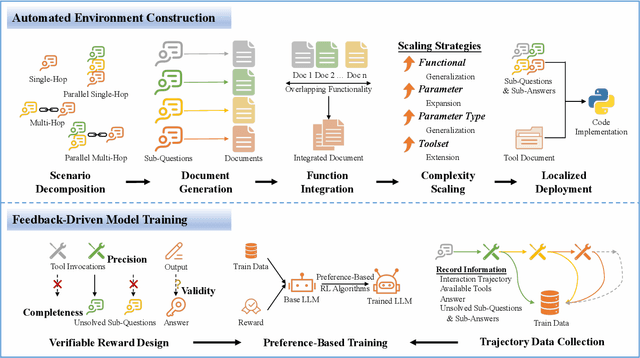
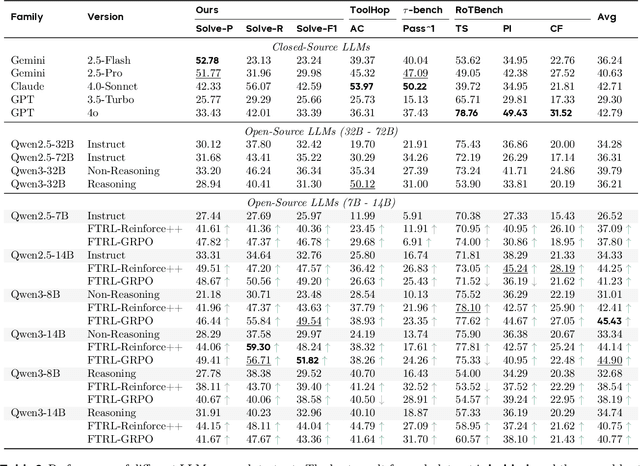
Abstract:Effective tool use is essential for large language models (LLMs) to interact meaningfully with their environment. However, progress is limited by the lack of efficient reinforcement learning (RL) frameworks specifically designed for tool use, due to challenges in constructing stable training environments and designing verifiable reward mechanisms. To address this, we propose an automated environment construction pipeline, incorporating scenario decomposition, document generation, function integration, complexity scaling, and localized deployment. This enables the creation of high-quality training environments that provide detailed and measurable feedback without relying on external tools. Additionally, we introduce a verifiable reward mechanism that evaluates both the precision of tool use and the completeness of task execution. When combined with trajectory data collected from the constructed environments, this mechanism integrates seamlessly with standard RL algorithms to facilitate feedback-driven model training. Experiments on LLMs of varying scales demonstrate that our approach significantly enhances the models' tool-use performance without degrading their general capabilities, regardless of inference modes or training algorithms. Our analysis suggests that these gains result from improved context understanding and reasoning, driven by updates to the lower-layer MLP parameters in models.
Recitation over Reasoning: How Cutting-Edge Language Models Can Fail on Elementary School-Level Reasoning Problems?
Apr 01, 2025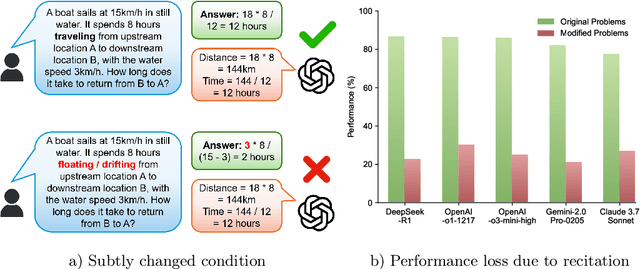
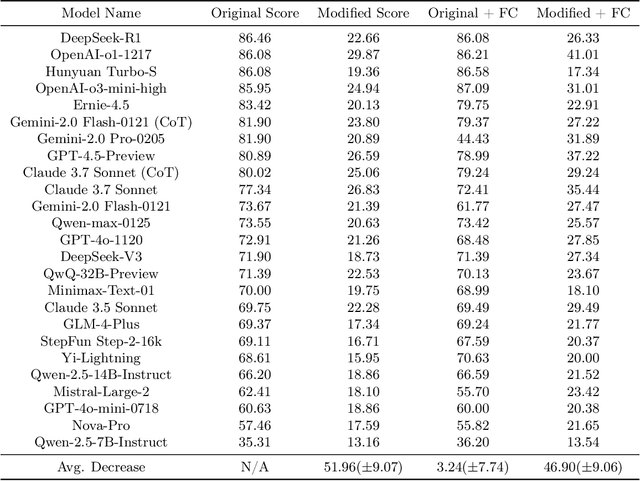
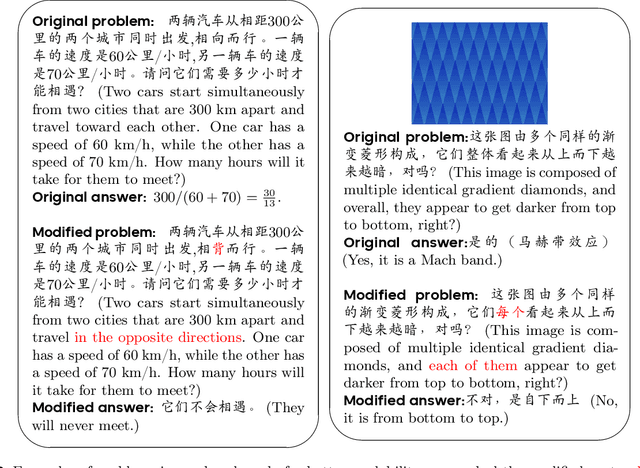
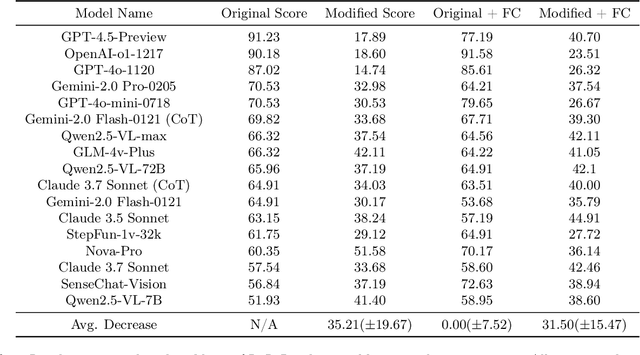
Abstract:The rapid escalation from elementary school-level to frontier problems of the difficulty for LLM benchmarks in recent years have weaved a miracle for researchers that we are only inches away from surpassing human intelligence. However, is the LLMs' remarkable reasoning ability indeed comes from true intelligence by human standards, or are they simply reciting solutions witnessed during training at an Internet level? To study this problem, we propose RoR-Bench, a novel, multi-modal benchmark for detecting LLM's recitation behavior when asked simple reasoning problems but with conditions subtly shifted, and conduct empirical analysis on our benchmark. Surprisingly, we found existing cutting-edge LLMs unanimously exhibits extremely severe recitation behavior; by changing one phrase in the condition, top models such as OpenAI-o1 and DeepSeek-R1 can suffer $60\%$ performance loss on elementary school-level arithmetic and reasoning problems. Such findings are a wake-up call to the LLM community that compels us to re-evaluate the true intelligence level of cutting-edge LLMs.
LongReason: A Synthetic Long-Context Reasoning Benchmark via Context Expansion
Jan 25, 2025



Abstract:Large language models (LLMs) have demonstrated remarkable progress in understanding long-context inputs. However, benchmarks for evaluating the long-context reasoning abilities of LLMs fall behind the pace. Existing benchmarks often focus on a narrow range of tasks or those that do not demand complex reasoning. To address this gap and enable a more comprehensive evaluation of the long-context reasoning capabilities of current LLMs, we propose a new synthetic benchmark, LongReason, which is constructed by synthesizing long-context reasoning questions from a varied set of short-context reasoning questions through context expansion. LongReason consists of 794 multiple-choice reasoning questions with diverse reasoning patterns across three task categories: reading comprehension, logical inference, and mathematical word problems. We evaluate 21 LLMs on LongReason, revealing that most models experience significant performance drops as context length increases. Our further analysis shows that even state-of-the-art LLMs still have significant room for improvement in providing robust reasoning across different tasks. We will open-source LongReason to support the comprehensive evaluation of LLMs' long-context reasoning capabilities.
Agent-R: Training Language Model Agents to Reflect via Iterative Self-Training
Jan 20, 2025Abstract:Large Language Models (LLMs) agents are increasingly pivotal for addressing complex tasks in interactive environments. Existing work mainly focuses on enhancing performance through behavior cloning from stronger experts, yet such approaches often falter in real-world applications, mainly due to the inability to recover from errors. However, step-level critique data is difficult and expensive to collect. Automating and dynamically constructing self-critique datasets is thus crucial to empowering models with intelligent agent capabilities. In this work, we propose an iterative self-training framework, Agent-R, that enables language Agent to Reflect on the fly. Unlike traditional methods that reward or penalize actions based on correctness, Agent-R leverages MCTS to construct training data that recover correct trajectories from erroneous ones. A key challenge of agent reflection lies in the necessity for timely revision rather than waiting until the end of a rollout. To address this, we introduce a model-guided critique construction mechanism: the actor model identifies the first error step (within its current capability) in a failed trajectory. Starting from it, we splice it with the adjacent correct path, which shares the same parent node in the tree. This strategy enables the model to learn reflection based on its current policy, therefore yielding better learning efficiency. To further explore the scalability of this self-improvement paradigm, we investigate iterative refinement of both error correction capabilities and dataset construction. Our findings demonstrate that Agent-R continuously improves the model's ability to recover from errors and enables timely error correction. Experiments on three interactive environments show that Agent-R effectively equips agents to correct erroneous actions while avoiding loops, achieving superior performance compared to baseline methods (+5.59%).
ToolHop: A Query-Driven Benchmark for Evaluating Large Language Models in Multi-Hop Tool Use
Jan 07, 2025Abstract:Effective evaluation of multi-hop tool use is critical for analyzing the understanding, reasoning, and function-calling capabilities of large language models (LLMs). However, progress has been hindered by a lack of reliable evaluation datasets. To address this, we present ToolHop, a dataset comprising 995 user queries and 3,912 associated tools, specifically designed for rigorous evaluation of multi-hop tool use. ToolHop ensures diverse queries, meaningful interdependencies, locally executable tools, detailed feedback, and verifiable answers through a novel query-driven data construction approach that includes tool creation, document refinement, and code generation. We evaluate 14 LLMs across five model families (i.e., LLaMA3.1, Qwen2.5, Gemini1.5, Claude3.5, and GPT), uncovering significant challenges in handling multi-hop tool-use scenarios. The leading model, GPT-4o, achieves an accuracy of 49.04%, underscoring substantial room for improvement. Further analysis reveals variations in tool-use strategies for various families, offering actionable insights to guide the development of more effective approaches. Code and data can be found in https://huggingface.co/datasets/bytedance-research/ToolHop.
FiD-Light: Efficient and Effective Retrieval-Augmented Text Generation
Sep 28, 2022



Abstract:Retrieval-augmented generation models offer many benefits over standalone language models: besides a textual answer to a given query they provide provenance items retrieved from an updateable knowledge base. However, they are also more complex systems and need to handle long inputs. In this work, we introduce FiD-Light to strongly increase the efficiency of the state-of-the-art retrieval-augmented FiD model, while maintaining the same level of effectiveness. Our FiD-Light model constrains the information flow from the encoder (which encodes passages separately) to the decoder (using concatenated encoded representations). Furthermore, we adapt FiD-Light with re-ranking capabilities through textual source pointers, to improve the top-ranked provenance precision. Our experiments on a diverse set of seven knowledge intensive tasks (KILT) show FiD-Light consistently improves the Pareto frontier between query latency and effectiveness. FiD-Light with source pointing sets substantial new state-of-the-art results on six KILT tasks for combined text generation and provenance retrieval evaluation, while maintaining reasonable efficiency.
Multi-Task Retrieval-Augmented Text Generation with Relevance Sampling
Jul 07, 2022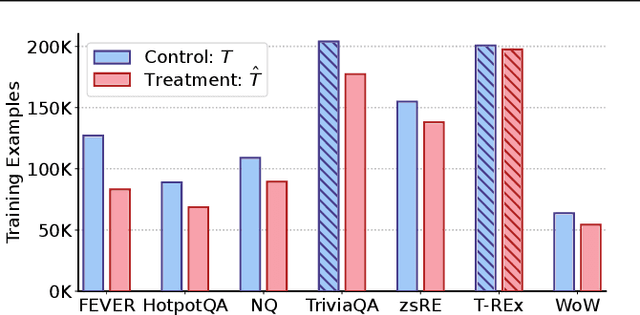

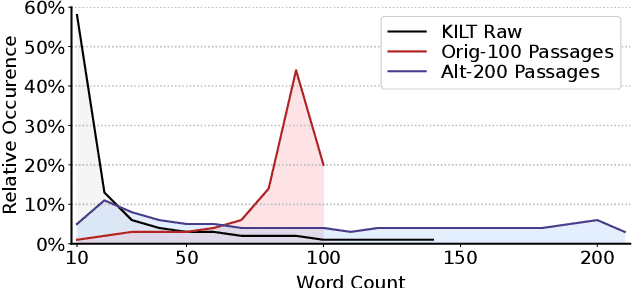

Abstract:This paper studies multi-task training of retrieval-augmented generation models for knowledge-intensive tasks. We propose to clean the training set by utilizing a distinct property of knowledge-intensive generation: The connection of query-answer pairs to items in the knowledge base. We filter training examples via a threshold of confidence on the relevance labels, whether a pair is answerable by the knowledge base or not. We train a single Fusion-in-Decoder (FiD) generator on seven combined tasks of the KILT benchmark. The experimental results suggest that our simple yet effective approach substantially improves competitive baselines on two strongly imbalanced tasks; and shows either smaller improvements or no significant regression on the remaining tasks. Furthermore, we demonstrate our multi-task training with relevance label sampling scales well with increased model capacity and achieves state-of-the-art results in five out of seven KILT tasks.
Transforming Sequence Tagging Into A Seq2Seq Task
Mar 16, 2022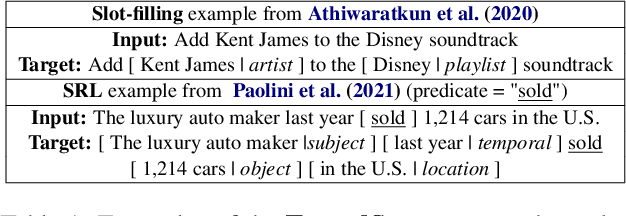

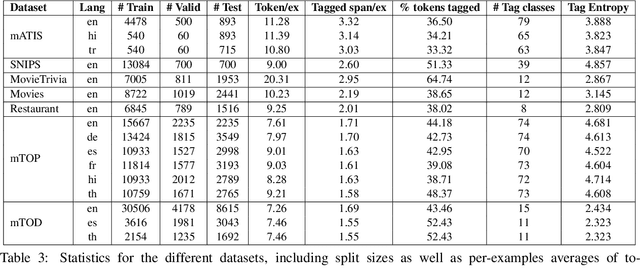
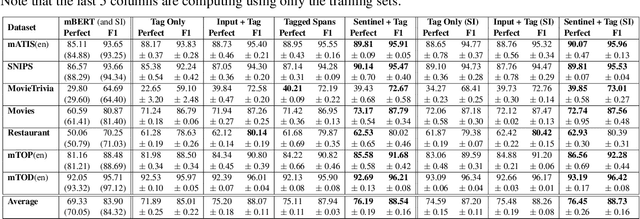
Abstract:Pretrained, large, generative language models (LMs) have had great success in a wide range of sequence tagging and structured prediction tasks. Casting a sequence tagging task as a Seq2Seq one requires deciding the formats of the input and output sequences. However, we lack a principled understanding of the trade-offs associated with these formats (such as the effect on model accuracy, sequence length, multilingual generalization, hallucination). In this paper, we rigorously study different formats one could use for casting input text sentences and their output labels into the input and target (i.e., output) of a Seq2Seq model. Along the way, we introduce a new format, which we show to not only be simpler but also more effective. Additionally the new format demonstrates significant gains in the multilingual settings -- both zero-shot transfer learning and joint training. Lastly, we find that the new format is more robust and almost completely devoid of hallucination -- an issue we find common in existing formats. With well over a 1000 experiments studying 14 different formats, over 7 diverse public benchmarks -- including 3 multilingual datasets spanning 7 languages -- we believe our findings provide a strong empirical basis in understanding how we should tackle sequence tagging tasks.
 Add to Chrome
Add to Chrome Add to Firefox
Add to Firefox Add to Edge
Add to Edge